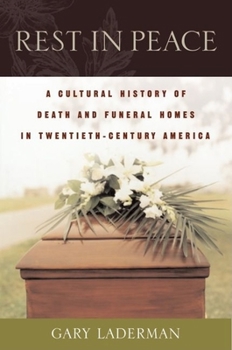Rest in Peace: A Cultural History of Death and the Funeral Home in Twentieth-Century America
Select Format
Select Condition 
Book Overview
Though it has often been passionately criticized--as fraudulent, exploitative, even pagan--the American funeral home has become nearly as inevitable as death itself, an institution firmly embedded in our culture. But how did the funeral home come to hold such a position? What is its history? And is it guilty of the charges sometimes leveled against it?
In Rest in Peace, Gary Laderman traces the origins of American funeral rituals, from the evolution...
Format:Hardcover
Language:English
ISBN:019513608X
ISBN13:9780195136081
Release Date:March 2003
Publisher:Oxford University Press, USA
Length:296 Pages
Weight:1.13 lbs.
Dimensions:1.1" x 9.4" x 6.3"
Related Subjects
Biological Sciences Biology & Life Sciences Botany Christianity Customs & Traditions Death Death & Grief Earth Sciences Economics Environmental Economics Environmental Science Environmental Studies Grief & Bereavement Industries & Professions Linguistics Other Religions, Practices & Sacred Texts Parenting & Relationships Politics & Government Politics & Social Sciences Public Affairs & Policy Religion Religion & Spirituality Religious Studies Ritual Science & Math Self-Help Service Sex Social Science Social Sciences Social Services & Welfare Textbooks Words, Language & GrammarCustomer Reviews
3 ratings
The flip side of the "American Way of Death" debate
Published by Thriftbooks.com User , 21 years ago
A few years ago, I read Jessica Mitford's "American Way of Death Revisited" a 1998 update of her classic book about the funeral industry. I came away with an extremely unfavorable opinion of the funeral industry as a whole. So when I saw "Rest In Peace", I thought that it might be a good idea to give consideration to the opposing viewpoint. Gary Laderman's sympathetic portrait of the funeral business makes some very valid points. He traces the origins of the industry from Civil War times and the gradual transition from funerals conducted at the home to the modern concept of the funeral home. Today's funeral director has assumed a myriad of responsibilities formerly left to the family. Laderman points out that conscientious funeral directors are on call 24 hours a day/7 days a week and make great sacrifices in their personal lives to take care of grief stricken families in their time of need. And the influx of immigrants from Spanish speaking countries, Asia and the Middle East has certainly complicated the task as funeral directors scramble to meet the particular needs of those indivduals. The author does devote several pages to what most people consider to be the real problem in the funeral business today. Two or three major corporations are beginning to dominate the industry. Led by Houston based SCI Corp., these companies have been buying up local funeral homes at an alarming rate. What is most deceptive about this practice is that they usually keep the same name, giving customers the impression that the business is still locally owned and operated. Furthermore, these giant corporations are vertically integrating, meaning that they now also own all or a piece of casket companies, florists etc. Inevitably, this kind of control results in price fixing and higher costs to consumers. These giant corporations have read the demographics and have determined that as the "baby boom" generation ages death will be a most profitable business in the coming decades. These corporations now control nearly a quarter of all of the funeral homes in this country. The author quotes a funeral director who makes the point "There's a big difference between corporations and family run funeral homes. Corporations are an assembly line. When you've got them in your office sell them everything you can. The interest of the sole proprietor is providing good service, helping a family through trying times." The author also discusses cremation and some of the alternative funeral services that are now emerging. All in all, I found this book to be a worthwhile read, though a bit long winded at times. I think it is very important that people become conversant in these issues before they are in the position of having to plan a funeral themselves. I would strongly recommend reading both Ladermans work as well as Jessica Mitford's offering to get a balanced view of the issues involved.
A Never-to-Be-Reconciled Fact of Life
Published by Thriftbooks.com User , 21 years ago
This is an unusual book because its faults are not that of the author, but that of American culture. A very detailed and informative history of death care in our society is laid out here, but the reading becomes repetitive and boring due to the fact that, as mortal beings, we cannot come to resolve issues about death. Topics such as embalming, the moral character of funeral directors, the viewing of the body, and the role of religion seem to be things that throughout the decades we are always circling around but never really confronting. Therefore, the same debates keep coming up on the same subjects. The most important point I take from this book is that we will never come to terms with death, but will always be psychologically held prisoners by the thought of it.
Morticians & Memory Images
Published by Thriftbooks.com User , 21 years ago
I thoroughly enjoyed reading this thought-provoking book concerning the management of human dead bodies in America. Though it is a scholarly work, it is filled with interesting anecdotes. Especially intriguing are accounts of the Kennedy family's private moments beside the dead President's open casket, the riots at the public viewing of Rudolph Valentino's body in New York, and the various ways in which death has been portrayed in the media. As a cultural history of the American funeral industry, it reveals morticians to be something other than stereotypical manipulative businessmen. Rather, many are "artists" who perform a significant service. Their skill at embalming and artistry in cosmetic preparation of dead bodies produces an all-important final "memory image" of the lost loved one for surviving family members and friends. This book provides an insightful perspective on a dark, but essential, subject.






